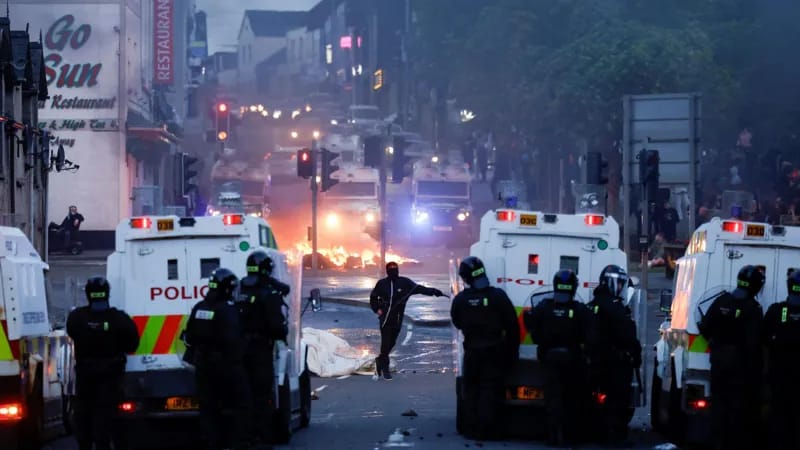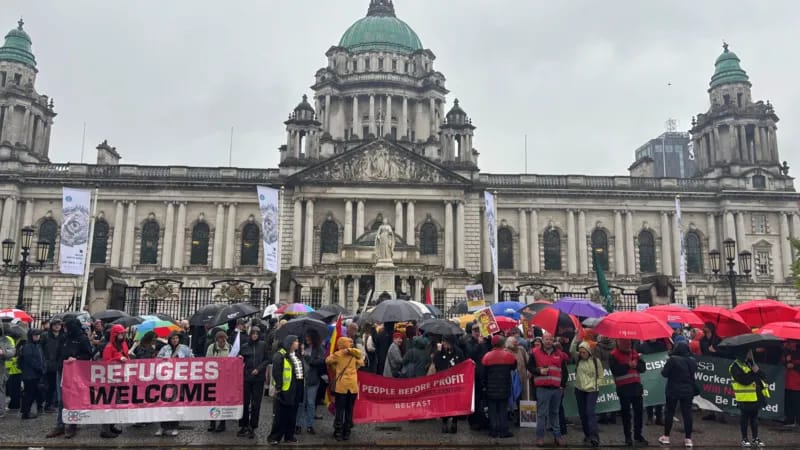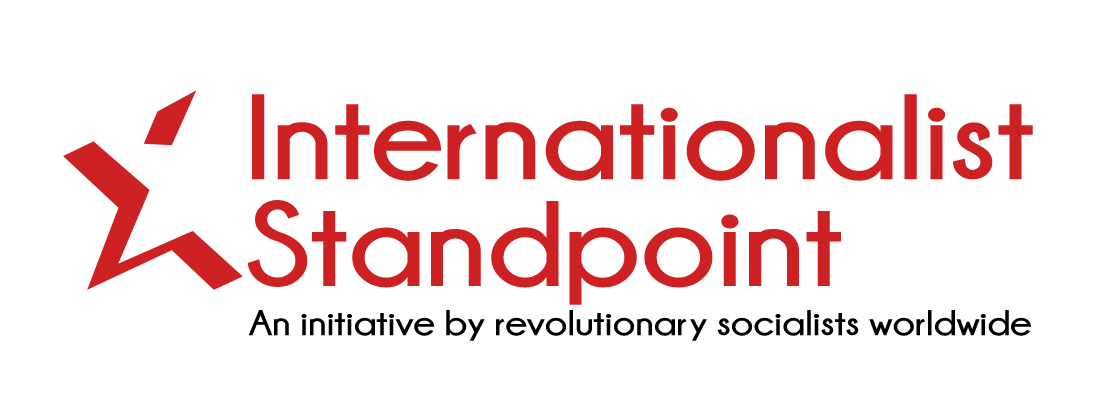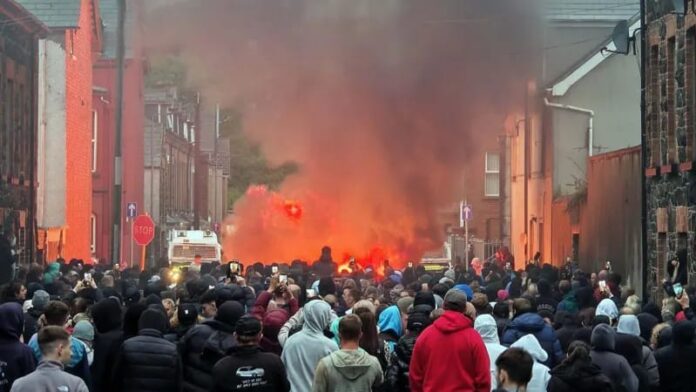Ciaran Mulholland, Lucy Simpson- N. Ireland
Ballymena in Northern Ireland has seen five nights of racist rioting and attacks on homes, which began on Monday, June 12th. The rioting began after a march by over 2,000 residents protesting on the news that two 14-year-old boys had been charged with a sexual assault on a teenage girl. The media reported that the 14-year-olds had required a Romanian translator in court. The rioting has targeted not just Romanian migrant workers, but migrants from other places who have seen their homes attacked and had to leave and seek shelter elsewhere.
Some of those who left were temporarily rehoused in a leisure centre in the nearby port town of Larne. The leisure centre was in turn, attacked and set on fire. But by then, those who had sheltered there had moved on. There has also been trouble in Carrickfergus, Newtownabbey and Coleraine in the same North Antrim/East Derry area, and in parts of Belfast and Portadown in County Armagh. More than 60 police officers have been injured in the rioting and dozens have been arrested.
Those who marched on Monday 12th claimed to do in opposition to reported attack on a young woman. Gender violence against woman and girls is of epidemic proportions in Northern Ireland. We also have one of the highest rates of femicide in Europe. Northern Ireland is one of the most unsafe places to live for females anywhere in Europe. A recent research project carried out by Ulster University suggests 98% of woman in Northern Ireland have experienced one form of violence or abuse in their lifetime. The report goes on to highlight that the worst experience of violence or abuse was most commonly committed by a stranger (29%). Often the perpetrator was known to the victim (23%) and occurred in their own home (26%). The research also found only one third of the participants felt able to speak out or report the violent incident with shame and embarrassment the main barriers to reporting. We need a robust challenge to the causes of gender-based violence. Last weeks events are racism, and not in any way justified by the charges brought against the two teenagers.

The Far Right and Racist Attacks
The violence occurred in Protestant areas only. There were rumours that migrants were to be forced out of the Catholic Beechmount area of West Belfast, an area where the far right is active, but a protest organised by People Before Profit and the trade union NIPSA saw off this threat. Far right violence has occurred in all areas of Ireland in recent years and is not confined to one community. When the Beechmount Residents Association organised an anti-racist protest last summer the organisers car was smashed up.
The far right is growing across all capitalist countries, and racist violence has erupted in in many towns and cities in Ireland and Britain in recent years. When street violence breaks out in Northern Ireland, it takes on an extra edge because of the existence of the armed paramilitary groups. A police report several years ago revealed an estimate of 12,500 members of loyalist paramilitary groups in Northern Ireland (in favour of maintaining the connection with Britain). The members of such groups are overwhelmingly male and young and there is a significant presence in the Protestant working class areas of the major towns and cities.
Over the last decades the loyalist paramilitary groups have sometimes formed links with fascist groups based in Britain, such as the National Front, the British National Party and the White Nationalist Party. At other times they have shunned such groups and expelled them from areas under their control. A noticeable feature of the events of the last week is that it is mostly centred in the area where the South East Antrim Ulster Defence Association is active. The SEA-UDA has broken from the mainstream UDA and is even more immersed in drug dealing and other forms of criminality. The Protestant working class areas of Belfast, where the mainstream UDA and the Ulster Volunteer Force are strongest, have largely remained quiet over the last week.
Ballymena is a largely working-class, and 85% Protestant, city with a population of 60,000. Many migrant workers are employed in local factories, especially in the food processing industry where conditions are poor and wages are low. Several other large employers have left Ballymena in the last years, including the Gallaghers cigarette factory and the Michelin tire factory, which once employed more than 3000 between them. The weakening of the industrial base means that any young Protestant men in the town who once would have expected to secure a good factory job on leaving school no longer have the same prospects. The closing of factories with a strong trade union tradition has also weakened the local workers movement.
In the past, the existence of a strong workers movement in towns such as Ballymena, where independently minded shop stewards (workplace representatives) could exercise influence in working class communities was vital in giving workers confidence to stand together whatever their religious background or ethnicity.

No Peace Dividend
The years since the Good Friday Agreement have not delivered the promised economic dividend. In fact, towns like Ballymena have shed better paid jobs, and many young people, especially young Protestant men, have seen their hopes for the future taken away. The factories that remain employ workers on low wages and in poor conditions and now are mostly staffed by migrant workers. The local hospital has closed, and both the high street and the shopping centre are increasingly dilapidated.
The local politicians have done nothing to address the social and economic problems facing the working class of Ballymena but instead continue to fight and squabble over the division of scarce resources. Indeed, in the week of the riots, the second biggest local news story was that the British government were providing an extra £50 million to invest in a new stadium for the Gaelic Athletic Association (GAA). The logic of sectarian division is that the Unionist parties argued that if the GAA, a sporting Association associated with the Catholic community, were to get increased funding, then there should be equal increased funding for sporting organizations more associated with the Protestant community, such as rugby and soccer. The struggle over scarce resources between Catholic and Protestant is inevitably replicated in struggles in Catholic and Protestant areas with their neighbours from ethnic minority groups. Division is caused by and accentuated by capitalism and in the current era of ‘perma-crisis’ divisions are sharpened. The far right find fertile ground for their poisonous ideas and seek to scapegoat minority groups.
During the years of the Troubles, there was very little inward migration to Northern Ireland, but this picture has changed completely over the last 20 years. There are migrant workers now from many countries, most prominently the Philippines, Portugal, East Timor, Eastern Europe, and India. When the worst years of the violence came to an end with the 1998 Good Friday/Belfast Agreement the population of Northern Ireland was overwhelmingly white. In the 2001 census only 0.8% of people identified as being a member of an ethnic minority. Today, that number has risen to 3.4% but this remains much lower than England at 18% and Scotland at 11%. Ballymena itself has an ethnic minority population of 4.9%.
There are now migrants living in all working-class areas, both Catholic and Protestant, and the large majority of working-class people are tolerant and friendly with their new neighbours. Most workplaces are now also integrated. Ironically, most working-class areas continue to be dominated by either the Catholic or the Protestant population, whilst at the same time, migrant workers can live in both areas.
A Proud Working-Class Tradition
Ballymena has as a proud working-class tradition. In the 1960s the Northern Ireland Labour Party won council seats in the area standing in opposition to both nationalism and unionism. Ballymena was also one of the areas where Marxists became organised from the 1970s. In 1977 a small group of activists from a Protestant background organised in opposition to Ian Paisley’s Democratic Unionist Party and opposed its moves to impose a form of fundamentalist Protestantism on the town by, for example, closing all public facilities on a Sunday. In the 1980s the Ballymena Young Socialists protested when local business backed a rugby tour to apartheid South Africa. The YS organised a counter-protest when the fascist National Front sought to build in the area in 1984 and when the White Nationalist Party tried again in 2004.
On Saturday, June 14th, United Against Racism organized a demonstration in the centre of Belfast, which was supported by the Northern Ireland Public Sector Alliance, the largest union in Northern Ireland. NIPSA is led by Marxists associated with the Committee for a Workers International (its President, Treasurer, General Secretary and Deputy General Secretary are all members of Militant Left affiliated to the CWI). NIPSA has played an exemplary role in countering racism and racist attacks over the course of the last several years. 1,000 attended the demonstration, including activists from other unions (Unite, the Communication Workers Union and Unison) which sent a powerful message and is an important marker of what is required to counter racism.
The trade union movement must act anywhere and everywhere that racism raises its head. Participants on the demonstration will have been very aware that it was taking place 25 miles away from the centre of events. The trade union movement has the power and the authority to pull workers together in the workplaces and in the communities at times of heightened tension and violence. This is not easy, but it is necessary work and importantly, preparation must begin in quieter periods when racist attacks have diminished in frequency and intensity.
The only sure way to defend working class migrants in working class communities is for those communities to mobilise in their defence. The organisations best placed to lead this defence are the trade unions, whose activists live in the working-class areas. The trade union movement has the power, authority and resources to mobilise its activists in each large town in Northern Ireland in preparation for the defence of migrant workers during any further outbreaks of violence. This is the approach advocated by Marxists during the long years of the Troubles when we argued that the trade unions should act to mobilise Catholics and Protestants to defend their neighbours in united action. Countering racism must be linked with a robust trade union lead campaign for improved conditions and pay for all workers, and for improved local health and education facilities.
The negative role of political parties which thrive on sectarian division must also be exposed. We need an end to a negative form of politics which reduces all issues to a squabble over the sharing out of scare resources, and which feeds the cancers of racism and sectarianism. We need a robust challenge to the causes of gender-based violence. We need a mass political alternative, based on the large numbers of trade union and community activists who reject sectarian division and racism, and who are prepared to struggle for a socialist future.



